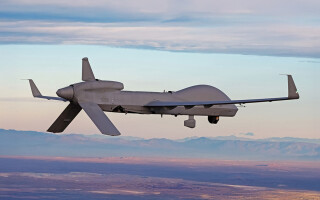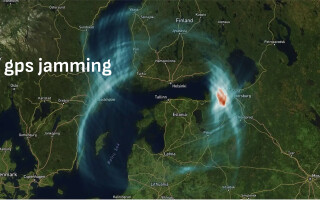Radiation-tolerant and radiation-hardened components in space power design
StoryJune 11, 2025

Radiation-tolerant and radiation-hardened components used in space systems must meet stringent radiation, temperature, and mechanical tests in order to succeed in mission-critical applications. Along with resilience, long-term cost effectiveness is one of the advantages of radiation-tolerant and radiation-hardened devices, as their use reduces the risk of mission failures and guarantees against the need for replacement and repair.
Power systems are integral to achieving reliable and successful space missions, but the harsh and unforgiving environment of space presents extreme environmental and operational challenges that space designers must mitigate. The relentless exposure of radiation from cosmic rays and solar flares poses a serious threat to electronic components, making the choice between radiation-tolerant parts, radiation-hardened components, and commercial-grade power components a critical decision in space power design.
Navigating and mitigating the dangers of radiation
Space is a treacherous landscape littered with high-energy particles that can wreak havoc on electronic circuits. High-energy particles produced by radiation have three main sources:
- Trapped radiation: particles (protons/electrons) from the sun and solar wind
- Transient galactic cosmic radiation (GCR): ionized atoms originating outside the solar system
- Solar particle events: particles created by solar flares and coronal mass ejections
These high-energy particles caused by radiation can cause several damaging effects on electronics. One is termed total ionizing dose (TID), which is characterized as an accumulated charge over a mission lifetime. TID causes hole-trapping (generated by radiation exposure) leading to voltage threshold shifts in metal-oxide-semiconductor field-effect transistors (MOSFETs). For example, an N-channel MOSFET will exhibit a negative Vth shift, whereas a P-channel MOSFET will exhibit a positive shift in Vth when exposed to long-term radiation. (Figure 1.)
.jpg)
[Figure 1 ǀ Schematic of N-channel MOSFET illustrating the basic effect of total ionization-induced charging of the gate oxide. Normal operation (a) and post irradiation (b) show the residual trapped positive charge (holes) that produces a negative threshold voltage shift. Image courtesy “Harsh Environments: Space Radiation Environment, Effects, and Mitigation,” Richard Maurer et al.]
Another radiation effect on electronics is called single-event effects (SEE), which result from fast heavy-particle collisions from galactic cosmic rays (GCR) and solar particle events. These effects can be destructive or nondestructive. An example of a destructive event would be single-event gate rupture (SEGR), which occurs when a charge, often deposited by an incident particle, builds up in the dielectric material around the gate of a device, such as a power MOSFET. This accumulation creates a strong localized electric field. If this field becomes intense enough to surpass the dielectric’s breakdown voltage, it creates a permanent low-resistance path through the gate oxide, resulting in device damage known as SEGR. An example of a nondestructive event would be single-event transient (SET), in which energized particles can cause sudden and temporary changes in voltage or current conditions for a deployed electronic part. These effects can lead to performance degradation, unpredictable malfunctions, and, in the worst cases, total system failures.
Commercial-grade components, designed solely for use on Earth where the atmosphere and magnetosphere provide significant shielding, simply do not possess the resilience required to withstand the extreme conditions of space. These devices lack the specialized design considerations, advanced materials, and rigorous testing protocols that are characteristic of radiation-tolerant and -hardened components. Because there is no opportunity for repair or replacement in the depths of space, every aspect of a space system must thus be engineered for utmost reliability. Therefore, commercial components are often inappropriate for space systems.
Radiation-tolerant versus radiation-hardened: a critical distinction
Low Earth orbit (LEO) satellites reside within an altitude range of approximately 160 km to 2,000 km (99.42 miles to 1,242 miles) above Earth’s surface. This orbital regime places them within the significant protective influence of the Earth’s magnetosphere. The magnetosphere acts as a natural barrier, largely deflecting high-energy particle fluxes, such as cosmic rays and Van Allen belt radiation. The magnetosphere’s inherent shielding mechanism substantially mitigates the probability of radiation-induced component degradation in LEO satellites compared to those in more distant orbits. For spacecraft in LEO, the typical annual radiation dose rates vary significantly based on orbital inclination. In low-inclination orbits, these rates generally fall between 100 and 1,000 rad(Si)/year. (Figure 2.)
However, for higher inclination orbits, the dose rates increase considerably, ranging from 1,000 to 10,000 rad(Si)/year, primarily due to a greater exposure to trapped electrons. The inner Van Allen belt is the primary source of trapped protons where the energy range can be between 10MeV up to 50 MeV. Radiation-tolerant components are designed to endure these radiation levels in low Earth orbit. Because the environment in LEO is less harsh and mission life is shorter than higher orbits such as geosynchronous orbit (GEO) and medium Earth orbit (MEO), space designers can use cost-optimized materials, like plastic. Rad-tolerant parts are also manufactured on high-volume production lines, making them ideal for large-scale satellite constellations.
The MEO and GEO satellites are located within the altitude range of 2,000 km and 35,790 km (1,242 miles to 22,239 miles) above the earth’s surface. At this altitude satellites radiation sources emanate from the inner and outer Van Allen belts, where proton energy can be 80MeV and above. Satellites in these orbits can experience radiation dose rates of 100 Krad to 1 Mrad over a 10 to 15-year mission.
Radiation-hardened components are engineered specifically to resist damage from high levels of radiation, ensuring their unwavering reliability in the harshest environments. To ensure long-term resilience against radiation effects, these components are subjected to stringent manufacturing and testing protocols. Radiation-hardened parts are typically assembled in ceramic packaging, which provides an extra layer of protection against radiation and other challenging space effects such as thermal fluctuations, vibration, and the vacuum of space. These characteristics make radiation-hardened parts ideal for longer space missions in the extremes of deep space where reliability is critical and failure is not an option.
Both radiation-tolerant and -hardened options demonstrate superior durability and advanced protective measures that are not just beneficial for space missions, but are also essential for the integrity of vital systems aboard satellites and spacecraft.
.jpg)
[Figure 2 ǀ Shown: LEO, GEO, and MEO and inner and outer Van Allen radiation belt.]
Rad-hard/rad-tolerant and enhanced reliability
Whether missions to Mars, deployment of satellites into low Earth orbit, or deep-space exploration, the requirement for systems that can endure certain radiation environments without succumbing to failure becomes vital. A power-supply failure can jeopardize not only individual satellites but entire networks, leading to monumental financial losses and thwarted scientific advancements.
Though radiation-tolerant and -hardened components may entail a higher initial investment compared to their commercial counterparts, they offer invaluable long-term cost efficiency by minimizing the risk of mission failure and the financial toll of replacement and repairs. Investing in robust technology upfront is a wise strategy to shield against the economic impacts of potential radiation-induced failures. Over the lifespan of a space mission, the savings generated by using reliable components can prove substantial.
Adhering to compliance standards guarantees a level of reliability that commercial parts can neither replicate nor compete with. The space industry is governed by stringent standards that dictate the use of components in aerospace applications. Renowned programs such as NASA’s guidelines and the European Space Agency’s mission requirements underscore the necessity of employing radiation-tolerant and -hardened components in both government and commercial space missions.
Rad-hard and -tolerant going forward
Integration of radiation-tolerant and radiation-hardened components in space power design must be a priority. Their enhanced reliability, resilience against radiation-induced failures, and alignment with industry standards are essential to the success of past, present, and future space missions. By investing in specialized technologies, the industry paves the way for safer and more successful operations in the challenging theater of space, ultimately propelling humanity’s exploration of the cosmos.
Chandra Hackenbruch is the Senior Product Marketing Manager for Space Products at Infineon Technologies, driving business strategy for the satellite space industry through market analysis, customer engagement, and product roadmap development. She has more than 24 years of experience in product marketing, project management, and manufacturing support; she also dedicates time to training, mentoring, and university recruiting to foster future talent.
Infineon https://www.infineon.com/






